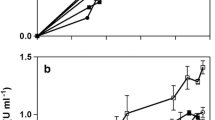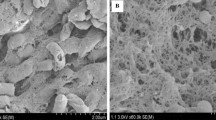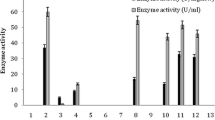Abstract
Immobilized cells of Bacillus subtilis HLZ-68 were used to produce d-alanine from dl-alanine by asymmetric degradation. Different compounds such as polyvinyl alcohol and calcium alginate were employed for immobilizing the B. subtilis HLZ-68 cells, and the results showed that cells immobilized using a mixture of these two compounds presented higher l-alanine degradation activity, when compared with free cells. Subsequently, the effects of different concentrations of polyvinyl alcohol and calcium alginate on l-alanine consumption were examined. Maximum l-alanine degradation was exhibited by cells immobilized with 8% (w/v) polyvinyl alcohol and 2% (w/v) calcium alginate. Addition of 400 g of dl-alanine (200 g at the beginning of the reaction and 200 g after 30 h of incubation) into the reaction solution at 30 °C, pH 6.0, aeration of 1.0 vvm, and agitation of 400 rpm resulted in complete l-alanine degradation within 60 h, leaving 185 g of d-alanine in the reaction solution. The immobilized cells were applied for more than 15 cycles of degradation and a maximum utilization rate was achieved at the third cycle. d-alanine was easily extracted from the reaction solution using cation-exchange resin, and the chemical and optical purity of the extracted d-alanine was 99.1 and 99.6%, respectively.






Similar content being viewed by others
References
Al-Zuhair S, El-Naas M (2011) Immobilization of Pseudomonas putida in PVA gel particles for the biodegradation of phenol at high concentrations. Biochem Eng J 56:46–50
Barbehenn RV (2010) Measurement of protein in whole plant samples with ninhydrin. J Sci Food Agric 69:353–359
Darah I, Nisha M, Lim SH (2015) Polygalacturonase production by calcium alginate immobilized Enterobacter aerogenes NBO2 cells. Appl Biochem Biotechnol 175:2629–2636
Dave R, Madamwar D (2006) Esterification in organic solvents by lipase immobilized in polymer of PVA–alginate–boric acid. Process Biochem 41:951–955
Friedman M (2010) Origin, microbiology, nutrition, and pharmacology of D-amino acids. Chem Biodivers 7:1491
Garay-Flores RV, Segura-Ceniceros EP, De León-Gámez R, Balvantín-García C, Martínez-Hernández JL, Betancourt-Galindo R, Ramírez ARP, Aguilar CN, Ilyina A (2014) Production of glucose oxidase and catalase by Aspergillus niger free and immobilized in alginate-polyvinyl alcohol beads. J Gen Appl Microbiol 60:262
Gotovtsev PM et al (2015) Immobilization of microbial cells for biotechnological production: modern solutions and promising technologies. Appl Biochem Microbiol 51:792–803
He SY, Lin YH, Hou KY, Hwang SC (2011) Degradation of dimethyl-sulfoxide-containing wastewater using airlift bioreactor by polyvinyl-alcohol-immobilized cell beads. Bioresour Technol 102:5609–5616
Hems BA, Page JK, Waller JG (2010) The use of ion exchange resins for separation of basic amino acids. J Chem Technol Biotechnol 67:77–80
Hoffer LJ (2016) Human Protein and Amino Acid Requirements. Jpen J Parenter Enter Nutr 40:460
Hu J, Yang Q (2015) Microbial degradation of di-n-butyl phthalate by Micrococcus sp. immobilized with polyvinyl alcohol. Desalination Water Treat 56:2457–2463
Huang Y, Pathirana C, Ye Q, Palaniswamy V (2015) Non-enzymatic transformation of dl -glyceraldehyde, 1,3-dihydroxyacetone, and pyruvaldehyde with primary amine to the same dl -alanine derivatives. Tetrahedron Lett 56:4516–4519
Kim Y, Koo BS, Lee HC, Yoon Y (2015) Improved production of isomaltulose by a newly isolated mutant of Serratia sp. cells immobilized in calcium alginate. Can J Microbiol 61:193–199
Krasňan V, Stloukal R, Rosenberg M, Rebroš M (2016) Immobilization of cells and enzymes to LentiKats®. Appl Microbiol Biotechnol 100:2535–2553
Mohapatra PKD, Mondal KC, Pati BR (2007) Production of tannase by the immobilized cells of Bacillus licheniformis KBR6 in Ca-alginate beads. J Appl Microbiol 102:1462–1467
Moozeh K, So SM, Chin J (2015) Catalytic stereoinversion of L-Alanine to deuterated D-Alanine. Angew Chem 54:9381
Pilone MS (2000) D-amino acid oxidase: new findings. Cell Mol Life Sci Cmls 57:1732–1747
Qiu W et al (2015) d-Alanine metabolism is essential for growth and biofilm formation of Streptococcus mutans. Mol Oral Microbiol 31:435–444
Radkov AD, Moe LA (2014) Bacterial synthesis of D-amino acids. Appl Microbiol Biotechnol 98:5363
Takenaka T, Ito T, Miyahara I, Hemmi H, Yoshimura T (2015) A new member of MocR/GabR-type PLP-binding regulator of d-alanyl-d-alanine ligase in Brevibacillus brevis. Febs J 282:4201
Umemura I, Yanagiya K, Komatsubara S, Sato T, Tosa T (1990) d -Alanine production by using asymmetric degrading activity of Candida maltosa. Ann N Y Acad Sci 613:659–662
Umemura I, Yanagiya K, Komatsubara S, Sato T, Tosa T (1992) d -Alanine production from dl -alanine by Candida maltosa with asymmetric degrading activity. Appl Microbiol Biotechnol 36:722–726
Wiese A, Syldatk C, Mattes R, Altenbuchner J (2001) Organization of genes responsible for the stereospecific conversion of hydantoins to α-amino acids in Arthrobacter aurescens DSM 3747. Arch Microbiol 176:187–196
Wu Z et al (2012) Characterization of the nitrobenzene-degrading strain Pseudomonas sp. a3 and use of its immobilized cells in the treatment of mixed aromatics wastewater. World J Microbiol Biotechnol 28:2679
Yamamoto S et al (2012) Overexpression of genes encoding glycolytic enzymes in Corynebacterium glutamicum enhances glucose metabolism and alanine production under oxygen deprivation conditions. Appl Environ Microbiol 78:4447–4457
Ying C, Lin HY, Chen Z, Megharaj M, Naidu R (2012) Biodegradation of crystal violet using Burkholderia vietnamiensis C09V immobilized on PVA–sodium alginate–kaolin gel beads. Ecotoxicol Environ Saf 83:108–114
Yu Z, Qiao H (2012) Advances in non-snake venom L-amino acid oxidase. Appl Biochem Biotechnol 167:1
Yuasa Y, Nagakura A, Tsuruta H (2001) Synthesis and sweetness characteristics of L-aspartyl-D-alanine fenchyl esters. J Agric Food Chem 49:5013–5018
Acknowledgements
This work was financially support by the Science Research and Technology Development Project of Nanning (20125193) and Wuzou (201201023).
Author information
Authors and Affiliations
Corresponding author
Rights and permissions
About this article
Cite this article
Zhang, Y., Li, X., Zhang, C. et al. Production of d-alanine from dl-alanine using immobilized cells of Bacillus subtilis HLZ-68. World J Microbiol Biotechnol 33, 176 (2017). https://doi.org/10.1007/s11274-017-2341-3
Received:
Accepted:
Published:
DOI: https://doi.org/10.1007/s11274-017-2341-3




